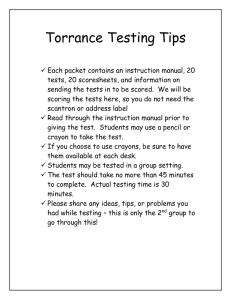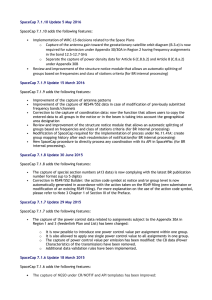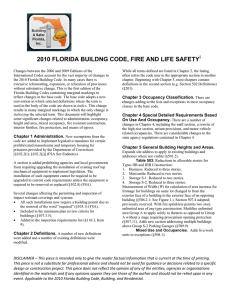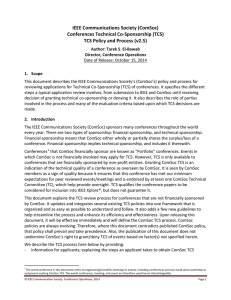State up How does Highlight front how
advertisement
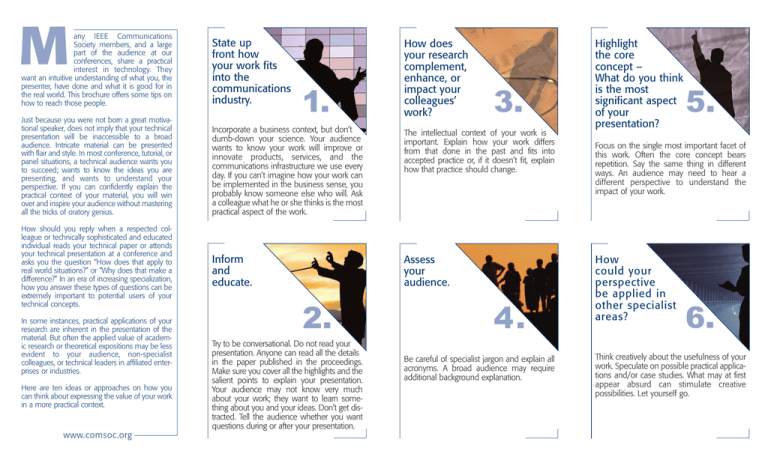
M any IEEE Communications Society members, and a large part of the audience at our conferences, share a practical interest in technology. They want an intuitive understanding of what you, the presenter, have done and what it is good for in the real world. This brochure offers some tips on how to reach those people. State up front how your work fits into the communications industry. Just because you were not born a great motivational speaker, does not imply that your technical presentation will be inaccessible to a broad audience. Intricate material can be presented with flair and style. In most conference, tutorial, or panel situations, a technical audience wants you to succeed; wants to know the ideas you are presenting, and wants to understand your perspective. If you can confidently explain the practical context of your material, you will win over and inspire your audience without mastering all the tricks of oratory genius. Incorporate a business context, but don’t dumb-down your science. Your audience wants to know your work will improve or innovate products, services, and the communications infrastructure we use every day. If you can’t imagine how your work can be implemented in the business sense, you probably know someone else who will. Ask a colleague what he or she thinks is the most practical aspect of the work. The intellectual context of your work is important. Explain how your work differs from that done in the past and fits into accepted practice or, if it doesn’t fit, explain how that practice should change. Inform and educate. Assess your audience. How should you reply when a respected colleague or technically sophisticated and educated individual reads your technical paper or attends your technical presentation at a conference and asks you the question “How does that apply to real world situations?” or “Why does that make a difference?” In an era of increasing specialization, how you answer these types of questions can be extremely important to potential users of your technical concepts. In some instances, practical applications of your research are inherent in the presentation of the material. But often the applied value of academic research or theoretical expositions may be less evident to your audience, non-specialist colleagues, or technical leaders in affiliated enterprises or industries. Here are ten ideas or approaches on how you can think about expressing the value of your work in a more practical context. www.comsoc.org 1. 2. Try to be conversational. Do not read your presentation. Anyone can read all the details in the paper published in the proceedings. Make sure you cover all the highlights and the salient points to explain your presentation. Your audience may not know very much about your work; they want to learn something about you and your ideas. Don’t get distracted. Tell the audience whether you want questions during or after your presentation. How does your research complement, enhance, or impact your colleagues’ work? 3. 4. Be careful of specialist jargon and explain all acronyms. A broad audience may require additional background explanation. Highlight the core concept – What do you think is the most significant aspect of your presentation? 5. Focus on the single most important facet of this work. Often the core concept bears repetition. Say the same thing in different ways. An audience may need to hear a different perspective to understand the impact of your work. How could your perspective be applied in other specialist areas? 6. Think creatively about the usefulness of your work. Speculate on possible practical applications and/or case studies. What may at first appear absurd can stimulate creative possibilities. Let yourself go. How does your innovation improve the design, development, or the process, or make implementation easier? 7. Don’t be modest. Tell your audience why your ideas make progress or are better than the status quo. Will your ideas make a product or service sell better? How? 8. If your ideas improve a product or a service, that increases its value in the marketplace. If your concepts offer a competitive advantage, your audience wants to know. Early adopters of innovative technology are eager to discover new and improved products and applications. Will your ideas impact standards or regulatory guidelines? 9. If your work impacts standards, examine which standards and how this impacts products and services. Be yourself. 10. Comfort adds to the effectiveness of your presentation. Let your character emerge as much as you can. Everyone has his/her own style. Your unique talents, skills, experience, personality and self-image complement your words. Self-assurance adds immeasurably to a convincing presentation. Bonus Tip Stimulate your audience with an attractive PowerPoint® presentation. Use graphics to support or enhance your ideas. Mix text with charts, graphs, illustrations, logos, and other visual stimuli. If the venue is appropriate and you are comfortable with animations and audio files, use them. A visually stimulating presentation adds another dimension to your ideas. T hrough surveys, communications engineers indicate that there is a need for more information on practical applications in communications technologies. These tips are offered to help add an applications perspective to technical presentations where practical applicability may not be apparent. These tips should be considered as complementary to common procedures used for preparation of technical presentations, such as time management, slide show development, and practice. www.comsoc.org



